NGOs fordern Ursula von der Leyen auf, die Green-Deal-Verpflichtung zum Export verbotener Chemikalien einzuhalten
BRÜSSEL/Hamburg, 12. September 2023.
85 Gesellschafts- und Umweltorganisationen fordern Ursula von der Leyen und die Europäische Kommission auf, die im Rahmen des Europäischen Green Deals eingegangene Verpflichtung einzuhalten und dafür zu sorgen, dass gefährliche Chemikalien, die in der EU verboten sind, nicht mehr für den Export produziert werden [1].
Kommissionsbeamte haben Campaigner und Industrielobbyisten darüber informiert, dass die Kommission beschlossen habe, vor dem Ende ihrer Amtszeit keinen Legislativvorschlag vorzulegen. Umweltkommissar Virginijus Sinkevičius sagte jedoch am Montagabend vor dem Umweltausschuss des Europäischen Parlaments (ENVI), er hoffe, dass „wenn der Ehrgeiz noch da ist, [die Kommission] in der Lage sein wird, ihn in diesem Mandat vorzuschlagen“, und beantwortete damit eine Frage zu verbotenen Chemikalien. [2]
Eoin Dubsky, Kampagnenleiter bei Ekō, sagte: „Präsidentin von der Leyen, Vizepräsident Šefčovič und Kommissar Sinkevičius müssen ihren Teams und der Welt klarmachen, was vor sich geht, um Giftexporte zu stoppen. Hat die Kommission noch vor, in dieser Amtszeit mit gutem Beispiel voranzugehen, oder geht sie die letzte Runde im Schritttempo an?“
Angeliki Lysimachou, Leiterin des Bereichs Wissenschaft und Politik bei PAN Europe, fügte hinzu: „Die Kehrtwende der Kommission ist völlig inakzeptabel. Unternehmen erzielen Gewinne, indem sie verbotene Pestizide, die für die Verwendung in Europa als zu gefährlich gelten, an Drittländer verkaufen und deren laxe Umwelt- und Gesundheitsvorschriften ausnutzen. Diese Doppelmoral ist eine kriminelle Praxis, und die Kehrtwende der Kommission zeigt, dass sie es versäumt hat, den Menschen- und Umweltrechten Vorrang vor privaten Profiten einzuräumen.“
„Die EU riskiert, ihre Glaubwürdigkeit zu verlieren, wenn sie sich nicht an ihre Versprechen hält, gegen diese Giftexporte vorzugehen. Es ist jetzt an der Zeit, mutige Schritte zum Schutz der Menschen und ihrer Umwelt zu unternehmen und nicht zurückzuweichen. Alle Menschen haben das Recht auf eine gesunde Umwelt und körperliche Unversehrtheit – unabhängig davon, ob sie EU-Bürger*innen sind oder in Drittländern leben. Ein Zögern der EU sendet eine fatale Botschaft an die Hunderte von Millionen Menschen, die weltweit unter Pestizid-Vergiftungen leiden“, so Susan Haffmans, Referentin für Pestizide bei PAN Germany.
267.000 Menschen haben inzwischen eine Petition für ein Exportverbot unterzeichnet, und mehr als 2.400 EU-Bürger haben sich an der öffentlichen Konsultation Anfang des Jahres beteiligt [3].
Die EU hat eine der strengsten Gesetzgebungen der Welt für Pestizide. Doch giftige Chemikalien, die in der Union wegen ihrer Auswirkungen auf die menschliche Gesundheit und die Umwelt verboten sind, werden immer noch in andere, oft ärmere Länder exportiert, was verheerende Folgen hat.
Diese gefährlichen Chemikalien schaden nicht nur Menschen und Ökosystemen außerhalb der EU, sondern gelangen auch in Form von Rückständen in importierte Lebensmittel nach Europa.
Mehr als 326 zivilgesellschaftliche Organisationen aus der ganzen Welt, Institutionen und Gewerkschaften haben im Dezember 2022 eine gemeinsame Erklärung an die Europäische Kommission gerichtet, in der sie ein Verbot der Ausfuhr von gefährlichen Chemikalien fordern, die in der EU verboten sind. [4]
Englisches Original dieser Pressemitteilung
Pressekontakte:
Eoin Dubsky, eoin@eko.org Phone: +31 641 636 410
Angeliki Lysimachou, angeliki@pan-europe.info +32 2318 6255
Susan Haffmans, susan.haffmans@pan-germany.org, +49 157 315 640 17
Notes:
[1] Open letter of 12 September 2023 https://s3.amazonaws.com/s3.sumofus.org/pdf/Letter_to_Commission_Protesting_Export_Ban_Delay_-_12_September_2023.pdf
[2] Video recording of Environment Commissioner at 20:51 minutes of 11 September 2023 https://multimedia.europarl.europa.eu/en/webstreaming/envi-committee-meeting_20230911-2000-COMMITTEE-ENVI
[3] Petition to Environment Commissioner, started November 2022 https://actions.eko.org/a/outlaw-exports-of-banned-chemicals
[4] Joint Statement by 326 civil society organisations, December 2022 https://eeb.org/wp-content/uploads/2022/11/Joint-statement_EU-exports_1-december-2022.pdf




